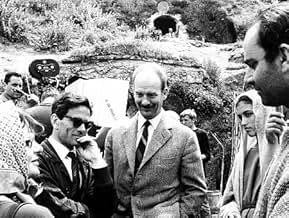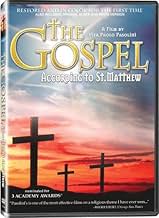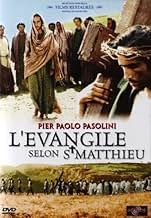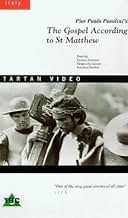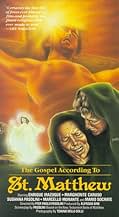VALUTAZIONE IMDb
7,6/10
14.305
LA TUA VALUTAZIONE
Segui la vita di Gesù Cristo secondo il Vangelo di Matteo.Segui la vita di Gesù Cristo secondo il Vangelo di Matteo.Segui la vita di Gesù Cristo secondo il Vangelo di Matteo.
- Regia
- Sceneggiatura
- Star
- Candidato a 3 Oscar
- 7 vittorie e 9 candidature totali
Juan Rodolfo Wilcock
- Caifa
- (as Rodolfo Wilcock)
Recensione in evidenza
For sure, the Christ of Il vangelo secondo Matteo is the most exceptional one ever to be depicted in cinema - a brilliant poetic fiction which brings it back to the pure level of words and gestures and displays the amazement and enthusiasm of the view of a privileged witness such as St. Matthew. A hard, implacable Christ, gentle to children and furious at salesmen, vehement against hypocrites, scribes and humbugs, unrelenting in his faith. He preaches the most difficult revolution given, the inner revolution of behaviour and its resulting decisions. The people that he is confronted with are sort of an Eisenstein'ian choir of faces in closeups with absent-minded or bright looks and ambiguous smiles of those who don't really understand. In this regard, it's actually a Pasolini'an choir of a mute mob witnessing happenings they feel subordinate to, a choir of anonymous figures, who suffer but not fight and who still dedicate themselves to a hope which becomes more and more unreachable.
Jesus and his 12 followers are a group of involved young men, who champion for revolutionary concerns. The youth and inexperience of the actors gives a fascinating sense of the fragility of the Christian movement itself in its very beginnings. The iconic-like closeups are a reminiscent of medieval, religious pictures whereas Enrique Irazoqui, who plays Jesus, seems like as if he descended right from a El Greco painting with his thin figure and slim, long face. The music from Bach and Mozart, as well as Blues recordings conveys additional meaning: The cry of revolt and the demand to be heard and received by the people and its authorities. It becomes utterly touching when the film dissolves into melancholy and passion by the power of Bach's classical music chorus and the blues.
The cinematography is remarkable and takes in many scenes the position of a third person telling the story. The intensely textual and dramaturgic reference to the biblical model, the amateurish performances of the actors and the waive of any pathos gives the film a strong naturalistic nuance. Jesus is less the son of god, but more an ideological fighter who gives radical speeches. But, Pasolini does not demystify the figure of Christ, nor does he question the set dogmas of the official church. He rather accentuates the social facets of Jesus' life and work and gives it an unforeseen political smack
Jesus and his 12 followers are a group of involved young men, who champion for revolutionary concerns. The youth and inexperience of the actors gives a fascinating sense of the fragility of the Christian movement itself in its very beginnings. The iconic-like closeups are a reminiscent of medieval, religious pictures whereas Enrique Irazoqui, who plays Jesus, seems like as if he descended right from a El Greco painting with his thin figure and slim, long face. The music from Bach and Mozart, as well as Blues recordings conveys additional meaning: The cry of revolt and the demand to be heard and received by the people and its authorities. It becomes utterly touching when the film dissolves into melancholy and passion by the power of Bach's classical music chorus and the blues.
The cinematography is remarkable and takes in many scenes the position of a third person telling the story. The intensely textual and dramaturgic reference to the biblical model, the amateurish performances of the actors and the waive of any pathos gives the film a strong naturalistic nuance. Jesus is less the son of god, but more an ideological fighter who gives radical speeches. But, Pasolini does not demystify the figure of Christ, nor does he question the set dogmas of the official church. He rather accentuates the social facets of Jesus' life and work and gives it an unforeseen political smack
- spoilsbury_toast_girl
- 1 nov 2008
- Permalink
Trama
Lo sapevi?
- QuizPier Paolo Pasolini used non-professional actors and cast local peasants, shopkeepers, factory workers, and truck drivers. For Mary at the time of the Crucifixion, he cast his own mother Susanna Pasolini.
- BlooperWhen they are taking Christ down from the cross, in the distance you can see a car driving around a corner.
- Citazioni
[last lines]
Christ: All authority has been given to me in heaven and earth. Go, therefore. And make disciples of all nations, baptizing them in the name of the Father, and of the Son and the Holy Ghost, teaching them to observe everything I have commanded you. And behold. I am with you always even unto the end of the world.
- Versioni alternativeThe 2007 DVD release features a colorized, English-dubbed version with a run time of 91 minutes and an Italian-language black and white version running 136 minutes.
- ConnessioniEdited into Histoire(s) du cinéma: Une histoire seule (1989)
- Colonne sonoreMatthäus Passion (BWV 244)
Written by Johann Sebastian Bach
nr 78: Wir setzen uns mit Tränen nieder
nr 47: Erbarme Dich (musical intro)
I più visti
Accedi per valutare e creare un elenco di titoli salvati per ottenere consigli personalizzati
- How long is The Gospel According to St. Matthew?Powered by Alexa
Dettagli
- Data di uscita
- Paesi di origine
- Lingua
- Celebre anche come
- The Gospel According to St. Matthew
- Luoghi delle riprese
- Castel Lagopesole, Avigliano, Basilicata, Italia(Sanhedrin trial of Jesus, in castle's courtyard)
- Aziende produttrici
- Vedi altri crediti dell’azienda su IMDbPro
Botteghino
- Lordo in tutto il mondo
- 16.572 USD
- Tempo di esecuzione2 ore 17 minuti
- Colore
- Mix di suoni
- Proporzioni
- 1.85 : 1
Contribuisci a questa pagina
Suggerisci una modifica o aggiungi i contenuti mancanti

Divario superiore
By what name was Il vangelo secondo Matteo (1964) officially released in India in English?
Rispondi
















